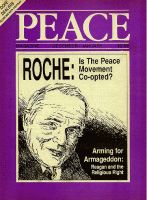
Peace Magazine Dec 1987-Jan 1988, page 26. Some rights reserved.
Search for other articles by Barbara Cooper here
A new peace education program, which uses role-playing to teach conflict resolution, has been developed for elementary students.
The thirty-lesson package emphasizes negotiation through active listening, anger management, and identification of personal feelings. Step-by-step, students act out peaceful solutions to everyday conflicts.
Developed in British Columbia by two staff members of the School Peacemakers Education Society and sponsored by the Public Education for Peace Society, the Peer Conflict Resolution Through Creative Negotiation program is in response to violence in the classroom and playground and is based on the premise of a link between interpersonal and global conflict:
The lessons were piloted for 4.5 months in Burnaby, with 140 grade 4 to 6 pupils divided into groups of about 20 for 40-minute classes twice a week. Following instruction about active listening, anger man-agreement and identifying personal feelings, students engaged in role-playing to negotiate, step-by-step, the resolution of conflicts. While many students seemed to enjoy the experience, a few were resistant: According to project worker Sandy Kalmakoff, the curriculum (especially the opening lessons) were "quite scary" for the children, who were asked to talk about their feelings. Nonetheless, students expressed "an unspoken hunger" for learning an alternative way to handle disputes, Kalmakoff said.
This eagerness sometimes led to an immediate sense of failure, however, when pupils tried the tactics outside the classroom with people unfamiliar with the process or before they, themselves, had learned all the steps.
Successful negotiation is attained when the conflict is resolved and participants each believe they got what they needed. "The underlying needs that were at the nub of the conflict have been met," Kalmakoff says. "There are no upset feelings left, the problem is solved and their relationship is once more where they wanted it to be. Both students are winners."
Another worker, Jeanne Shaw, says the program provides the skills necessary to resolve interpersonal conflicts. Kalmakoff and Shaw found beforehand that some children, more often girls than boys, would try to talk things out but lacked structure.
While favorable, the results of the program were not exactly what Kalmakoff and Shaw expected. They had planned for students to learn the actual steps of negotiation so that they would know and be able to explain them to others. Instead, however, there was not enough time to learn the steps fully, but there was a clear change in behavior in some children.
Teachers noticed changes in students' reactions to conflicts in the classroom and no longer had to police conflicts.
Response from parents was generally positive, as well, according to Shaw. "A few said they hadn't noticed any change, but they weren't surprised because of the short time period involved. Others said they had seen evidence of the skills being used with siblings."
Ideally, says Shaw, the program needs to be formally presented for about five months, with continual reinforcement of the concepts and facilitation of situations, afterwards, so that students can resolve conflicts on their own. The goal is to integrate the negotiation skills within the year.
To critics who believe such curriculum has no place in schools, Shaw says schools must teach how to deal with conflicts, and that this program offers students these skills.
Kalmakoff adds that the course has a "strong connection" to government-prescribed social studies curricula and also deals with language and communication skills.
The curriculum guide includes thirty lesson plans and an extensive introduction geared to help these unfamiliar with conflict resolution to understand the curriculum.
Although funding for the project expired several months ago, Shaw and Kalmakoff plan to be available as consultants and to do workshops based on their program.
To order the curriculum, contact Peace Resource Centre, 28-6th St, New Westminster, B.C., V3L 2Y8. Ph. 522-1123.
Barbara Cooper is school and community liaison member of School Peacemakers Education Project, and a teacher-librarian at School District #36 in Surrey.

Peace Magazine Dec 1987-Jan 1988, page 26. Some rights reserved.
Search for other articles by Barbara Cooper here